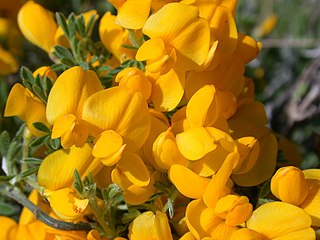
Cytisus is a genus of about 50 species of flowering plants in the family Fabaceae, native to open sites in Europe, western Asia and North Africa. It belongs to the subfamily Faboideae, and is one of several genera in the tribe Genisteae which are commonly called brooms. They are shrubs producing masses of brightly coloured, pea-like flowers, often highly fragrant. Members of the segregate genera, Calicotome and Lembotropis are sometimes included in Cytisus.

Crambe is a genus of about 20 species of annual and perennial flowering plants in the cabbage family Brassicaceae, native to a variety of habitats in Europe, Turkey, southwest and central Asia and eastern Africa. They carry dense racemes of tiny white or yellow flowers on stems above the basal leaves.

Cineraria is a genus of flowering plants in the sunflower family, native primarily to southern Africa with a few species farther north. The genus includes herbaceous plants and small subshrubs.

Guizotia abyssinica is an erect, stout, branched annual herb, grown for its edible oil and seed. Its cultivation originated in the Ethiopian highlands, and has spread to other parts of Ethiopia. Common names include noog/nug ; niger, nyger, nyjer, or niger seed ; ramtil or ramtilla; inga seed; and blackseed.

Lippia is a genus of flowering plants in the verbena family, Verbenaceae. It was named after Augustus Lippi, (1678-1705), a French naturalist and botanist. He was killed in Abyssinia. The genus contains roughly 200 species of tropical shrubs that are found around the world. Plants are fragrant due to their essential oils, which vary between species but may include estragole, carvacrol, linalool, or limonene. The leaves of certain species, such as L. graveolens, can be used as a culinary herb similar to oregano.
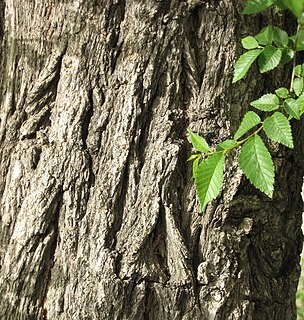
Ulmus canescens Melville is a small deciduous tree occasionally known by the common names grey elm, grey-leafed elm, and hoary elm. Its natural range extends through the lands of the central and eastern Mediterranean, from southern Italy, the islands of Sicily, Malta, Crete, Rhodes and Cyprus, to Turkey, and as far south as Israel, where it is now considered rare and endangered in the wild. The tree is typically found amidst the comparatively humid coastal woodlands and scrublands.
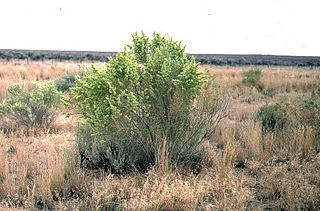
Atriplex canescens, chamiso, chamiza, four wing saltbush, four-wing saltbush, and fourwing saltbush, is a species of evergreen shrub in the family Amaranthaceae native to the western and midwestern United States.
Callitris canescens is a species of conifer in the Cupressaceae family. It is found only in Australia.
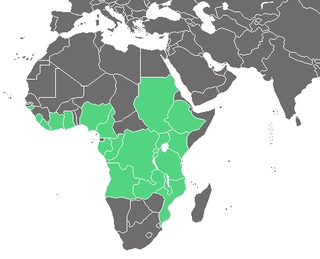
Bersama abyssinica is a species of medium-sized evergreen tree in the Francoaceae family. The leaves are pinnately divided with a strongly winged rachis. The inflorescence is a spike.

Geraea canescens, commonly known as desert sunflower, hairy desert sunflower, or desert gold, is an annual plant in the family Asteraceae. "Geraea" in its scientific name comes from the Greek geraios, referring to the white hairs on the fruits.
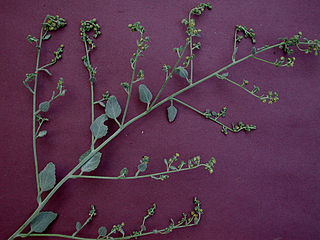
Dicoria canescens is a North American flowering plant in the daisy family known by several common names including desert twinbugs and bugseed. This is a desert plant of the southwestern United States and northwestern Mexico, found in Sonora, Baja California, southern California, Nevada, Arizona, Utah, southwestern Colorado, and northwestern New Mexico.
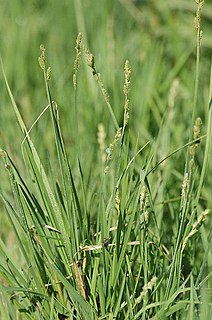
Carex canescens L. is a perennial species of plants in the family Cyperaceae growing in damp forests and wetlands. It is widespread across much of Europe, Asia, Australia, New Guinea, North America, and southern South America.
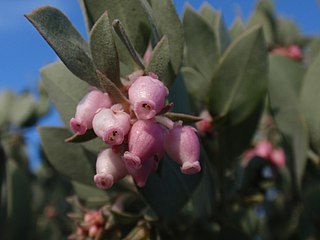
Arctostaphylos canescens, common name hoary manzanita, is a species of manzanita.

Oxytenanthera is a genus of African bamboo Bamboos are members of the grass family Poaceae.

Dieteria canascens is an annual plant or short lived perennial plant in the, known by the common names hoary tansyaster and hoary-aster.
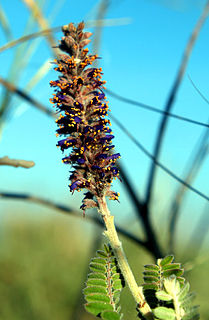
Amorpha canescens, known as leadplant, downy indigo bush, prairie shoestring, or buffalo bellows, is a small, perennial semi-shrub in the pea family (Fabaceae), native to North America. It has very small purple flowers with yellow stamens which are grouped in racemes. Depending on location, the flowers bloom from late June through mid-September. The compound leaves of this plant appear leaden due to their dense hairiness. The roots can grow up to 5 m (16 ft) deep and can spread up to 1 metre radially. This plant can be found growing in well drained soils of prairies, bluffs, and open woodlands.

Erythrina abyssinica is a tree species of the genus Erythrina belonging to the plant family of the Fabaceae described by Augustin Pyramus de Candolle in 1825. This leguminous tree species is native to East Africa, Eastern DRC and southern Africa.

Diospyros abyssinica is a tree species in the Ebenaceae family which is native to Sub-Saharan Africa.
The Field Elm cultivar Ulmus minor 'Cretensis' [:from Crete] was first mentioned by Nicholson in Kew Hand-List Trees & Shrubs Vol.2 (1896), as Ulmus campestris var. cretensis, without description. A 1908 herbarium specimen at Kew Gardens with an accompanying description suggests that 'Cretensis' is not synonymous with Ulmus minor var. canescens, also present on Crete.

















